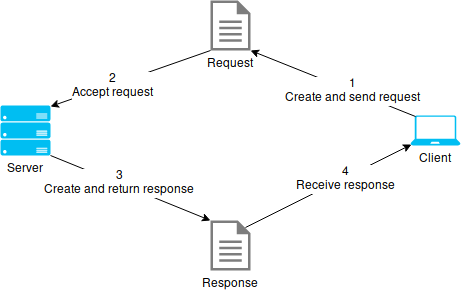How to understand a web application?
I my article I would like to briefly explain how a web application works as simply as possible without covering more detailed topics like DNS, domain or IP.
To put it very simply - a web application is a computer program which is used by means of another computer program. In order to allow one program to use another one they need to communicate.
To communicate with a web application we apply certain rules called HTTP protocol.
A web browser is one of many clients of a web application. The term client has much more examples - like a popular program for a terminal called cURL.
Web apps differ from desktop applications (e.g. Photoshop) - they don’t require installation on our computers. We can say that they are installed on a computer called server and we have an access to them through the Internet.

If we look at the graphics above we may find four elements as well as four processes accompanying each of them.
The best way to learn is by example that’s why I will solve this process describing what happens when we type URL address into our web browser.
Client
Providing any chosen URL, a window browser is creating and sending a HTTP request to a server. URL (Uniform Resource Locator) address clearly points out a specific resource - it can be an image, HTML page or JavaScript file.
Server
A server has to (should) accept your request. When it does then it creates and returns the response which the client (a browser) receives.
In the simplest example which is HTTP server, the server (application) sends in the response content of the files located on the server disc. In this case we say about serving static files.
A word server has many meanings. One of them is defining a machine, a computer. A server is also an application which is installed on such computer. Apache or nginx are examples of HTTP servers. We can say that they “serve” websites.
Request - Response
It’s worth saying a few words more about HTTP requests and responses.
The client sends a request to a server in the form of a message which has precisely defined format:
- HTTP method
- HTTP headers
- The body of the message (optional)
A server answers for a request sending a response. Here the format is also precisely determined.
We have as follows:
- Response status
- HTTP headers
- The body of the message (optional)
HTTP protocol is much more complex and interesting idea, that’s why my next articles will cover most popular issues regarding it.
Please feel free to comment about web apps topics which seems interesting to you.
Looking forward to your feedback!

Congratulations @annarozmus! You have completed the following achievement on the Steem blockchain and have been rewarded with new badge(s) :
Click here to view your Board of Honor
If you no longer want to receive notifications, reply to this comment with the word
STOPCongratulations @annarozmus! You received a personal award!
You can view your badges on your Steem Board and compare to others on the Steem Ranking
Vote for @Steemitboard as a witness to get one more award and increased upvotes!